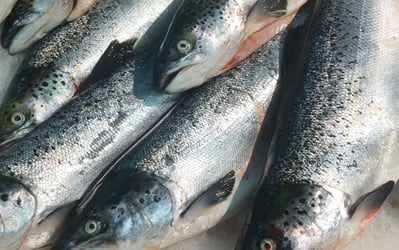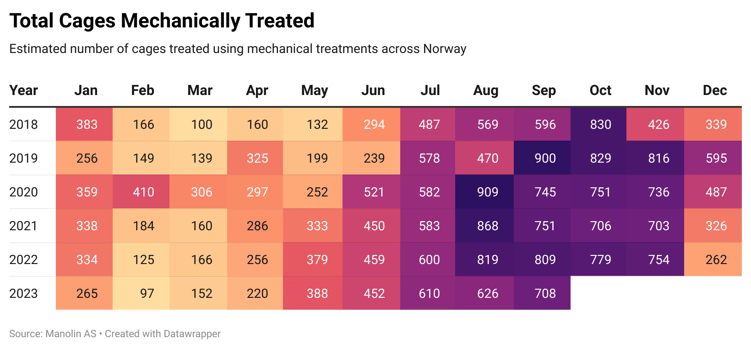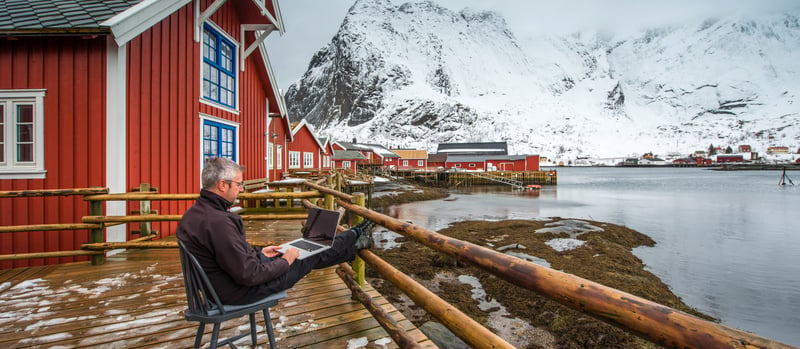Confronting Winter Wounds in Salmon Farming
 By
Manolin
·
6 minute read
By
Manolin
·
6 minute read
Winter wounds, also known as ulcers, have been a known issue in the industry for nearly 40 years. However, their increasing prevalence, often linked to the rise in mechanical sea lice treatments, has once again made them a prominent topic of discussion and challenge within the farming community and the industry at large. Recent data and reports from the past few years estimate that the complications arising from winter sores result in annual damages of approximately 750 million dollars, or around 8 billion NOK.
This article will explore various aspects of winter wounds and their impact on the industry, covering topics such as:
- Review the history of the disease and key research breakthroughs.
- Discuss the impacts of the disease on farm operations and business.
- Explore the science behind winter wounds and their challenges to the business.
- Examine current options for farmers, including vaccines, feeds, genetics, and phages, to combat the disease.
We wanted to start out with a disclaimer that the topic we're discussing today will delve into some scientific details on fish health topics that we are certainly not fully qualified to be sources of truth on - put simply, we are not trained or practicing veterinarians.
If you are a farmer, however, we would highly recommend discussing the topic with a veterinarian you know. That said, what we want to do is put a business lens and analysis on top of the disease, since so many of these fish health discussions have business and financial implications behind them. In order to do that, we have to speak on some of our understanding of the biology behind it.
Alright then, what are winter ulcers and why do they even matter?
Winter Ulcers: A Short History Lesson
The disease known as winter ulcers comes under a couple of different names. You'll also see it referenced as winter wounds and cold-water ulcers, but typically they all reflect the same challenge. It affects Atlantic Salmon, typically in colder water temperatures, and was recognized by researchers as a disease in the 1980s. The wounds typically look like ulcers. As the water temperatures rise, farmers typically see the wounds go away.
For the most part, mortality associated with the disease isn’t extremely high, and many of the infected animals have shown the ability to recover from these wounds over time. As we read through some of the history and research associated with the disease, what we found was a timeline of discoveries that taught researchers and scientists more and more about the illness and how to combat it.
In the early 90s, it was hypothesized that the wounds were caused by blood clots in the skin tissue that were disrupted by some sort of mechanical disruption, such as a crowding event, which would expose the wound. Some papers even suggested that high iron in the fish’s diets could be the cause that led to these blood clots. Other studies suggested that the wounds could be the result of a bacteria, but it wasn’t until around the early 2000s that scientists were able to find the key discoveries that linked the disease specifically to a bacteria called Moritella viscosa. That discovery was key, as it gave scientists the answer to what causes these wounds, and then we could develop solutions to try and combat it.
 Why Skin Lesions Appear on Farmed Salmon
Why Skin Lesions Appear on Farmed Salmon
In the years since, there have also been other strains of bacteria, such as Tenacibaculum, which can also cause the same wounds. That’s where the science currently stands: it’s understood that bacteria are the cause, and there are two types of bacteria that can cause the disease.
While bacteria are the cause of the disease, skin lesions to the animals, such as those occurring during treatments for conditions like sea lice, often act as catalysts. These treatments open up wounds, enabling the bacterial culture to grow even more.
Furthermore, these sea lice treatments are part of the reason why these winter wounds have become a much more significant problem for the industry.
Growing Trend of Mechanical Treatments
Over the last ten years, the number of mechanical sea lice treatments has continued to grow, as it's become the standard method for treating fish to meet sea lice regulations in the country. With the growth of mechanical sea lice treatments, so too has been the case with winter wounds, and it makes sense. The bacteria is a naturally occurring organism in our oceans, and the salmon's two major defenses against it are its skin and scales. When those skin and scales are injured, you are giving the bacteria direct access to the animal's flesh. This is no different than your mother's insistence that you make sure to sanitize any cuts you got as a kid, but now our salmon are just getting too many scrapes and cuts.

By the Norwegian Veterinary Institute's health numbers in 2022, it was reported that winter wounds were detected at about 433 of over 800 sites, or just around 50% of the entire industry. At that rate, along with estimates on total losses a farm can experience from the wound, such as mortality and downgrades in harvest quality, it's estimated that these wounds cost the industry 750 million dollars each year. The true numbers are likely to be even higher, however, since this is not a notifiable disease that the government tracks consistently, as it is a disease that doesn't spread from farm to farm.
Financial Impact of Winter Wounds
The financial impact of winter wounds can be quite substantial to a business as well. There's the obvious impact that if the wounds are severe enough, the animal can die, but another big issue is the quality of the end product. In 2022, Lerøy highlighted that they saw an average decline in fish prices of 18% due to these challenges.
With such a significant impact, there's no shortage of interest from supplier companies, the government, and the farmers themselves to solve this challenge. The process to find solutions follows the same pattern that we see in human health or other agricultural practices. The world sees challenges happening with the health of their animals, which funds research to find infection vectors and the cause of the problem. That eventually leads to the development of vaccines, therapeutics, and other scaled-up solutions to mitigate the challenge. That’s happened with winter wounds over the last 30+ years, but why is it still a problem?
Well, the short answer to that question is that while researchers are quite confident about the cause of the problem, none of the solutions available are 100% effective at solving it. We'll walk you through a few categories of them - vaccines, specialized feeds, genetics, phages, antibiotics, and operations - and talk about what the challenges are with each of them.
Current Solutions to Winter Wounds in Salmon
Vaccines
Vaccines are the obvious first solution that should make a huge impact. Compared with shrimp or lower-value species like tilapia, vaccines are fortunately a feasible solution for salmon, and many have been developed for winter wounds. At this point, almost all farmed salmon are vaccinated against Moritella, but the effectiveness has not been great. In the same report from the Veterinary Institute mentioned earlier, 77% of farms surveyed that used a vaccine still saw developments of winter wounds. There has also been new research suggesting that the bacterium has many different strains, and the effectiveness of the vaccines could be strengthened by targeting specific strains better. For Tenacibaculum, there hasn’t been a vaccine developed yet.
Functional Feeds
The next category is functional feeds. Most major feed companies, like Biomer, Skretting, and Cargill, offer solutions intended to boost the animal’s health of their skin and mucus layers, enabling a better proactive barrier to reduce lesions as well as faster recovery if lesions develop. Solutions like probiotics from companies like Privewo target improved and robust animal health. These solutions make sense, as they attempt to boost the immune response capability of the fish. However, the challenge here becomes timing and cost as a preventative solution. These functional feeds cost more, and timing them correctly to get the intended value is extremely challenging. For example, if a farm unfortunately gets hit with a large sea lice outbreak and the fish need to be treated multiple times, it’s possible that no matter how much preventative solution is used, there is just no way to avoid the stress that the fish have to undergo.
Genetics
Another solution is genetics, which also has a lot of practical logic behind it. The idea is to selectively breed fish that are stronger and recover faster from these challenges. The science makes sense, but the real-world challenge is that breeding programs in salmon take time. The genetics companies working on this have only bred roughly 15 or so generations in the entire history of salmon farming, so there simply isn’t enough genetic diversity yet to truly solve this challenge.
Bacteriophages & Antibiotics
The last category of solutions are potentially the most effective ones, but both share challenges along the regulatory and environmental angles, and that’s bacterial phages and antibiotics. Without diving too deep into either of these today, the limits to antibiotic use and the downstream impact from them keep them from being a great solution. Bacteriophages, while having great potential, still face regulatory barriers that prevent them from scaling as a solution. An entire episode was done on phages last year for those interested in a full breakdown.

Addressing the Challenge: A Collaborative Approach
When we put all of this together, what we see is a challenging situation for everyone involved. The solution and the common thread between everything seem to be the same. We know what causes the issue, we know our toolbox of solutions, so the best solution is to ensure we do preventative work. This means taking action before the cold temperatures come in, strengthening the health of the fish with good nutrition and smolt quality, and limiting the amount of sea lice treatments.
However, in practice, when we have to factor in the costs and the financial risks involved, the puzzle becomes much more complex. It turns into a very difficult decision to overspend on solutions and not see a return on investment if things go south. At the end of the day, that’s always a possibility with farming. That said, we want to make it clear that while we believe it’s a challenge, we are far from saying it’s an unsolvable one. On the contrary, we believe what we’re seeing in the current situation is a lot of research, new projects, and great developments being made. It’s just important to keep this in perspective.